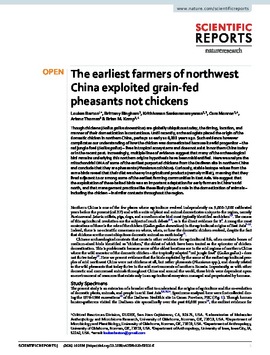| dc.contributor.author | Barton, Loukas | |
| dc.contributor.author | Bingham, Brittany | |
| dc.contributor.author | Sankaranarayanan, Krithivasan | |
| dc.contributor.author | Monroe, Cara | |
| dc.contributor.author | Thomas, Ariane | |
| dc.contributor.author | Kemp, Brian M. | |
| dc.date.accessioned | 2020-03-06T15:48:41Z | |
| dc.date.available | 2020-03-06T15:48:41Z | |
| dc.date.issued | 2020-02-13 | |
| dc.identifier.citation | Barton, L., Bingham, B., Sankaranarayanan, K. et al. 2020. The earliest farmers of northwest China exploited grain-fed pheasants not chickens. Sci Rep 10, 2556. https://doi.org/10.1038/s41598-020-59316-5 | en_US |
| dc.identifier.uri | https://hdl.handle.net/11244/323799 | |
| dc.description.abstract | Though chickens (Gallus gallus domesticus) are globally ubiquitous today, the timing, location, and manner of their domestication is contentious. Until recently, archaeologists placed the origin of the domestic chicken in northern China, perhaps as early as 8,000 years ago. Such evidence however complicates our understanding of how the chicken was domesticated because its wild progenitor – the red jungle fowl (Gallus gallus) – lives in tropical ecosystems and does not exist in northern China today or in the recent past. Increasingly, multiple lines of evidence suggest that many of the archaeological bird remains underlying this northern origins hypothesis have been misidentified. Here we analyze the mitochondrial DNA of some of the earliest purported chickens from the Dadiwan site in northern China and conclude that they are pheasants (Phasianus colchicus). Curiously, stable isotope values from the same birds reveal that their diet was heavy in agricultural products (namely millet), meaning that they lived adjacent to or among some of the earliest farming communities in East Asia. We suggest that the exploitation of these baited birds was an important adaptation for early farmers in China’s arid north, and that management practices like these likely played a role in the domestication of animals – including the chicken – in similar contexts throughout the region. | en_US |
| dc.description.sponsorship | The original isotopic analyses of these remains were conducted in collaboration with Seth Newsome (then at the Carnegie Institution of Washington) and Chen Fahu (Lanzhou University), with funding from the Wenner-Gren Foundation (awarded to L.B.). The University of Oklahoma provided funding for all molecular analyses (through B.M.K.). Open Access fees paid for in whole or in part by the University of Oklahoma Libraries | en_US |
| dc.language | en_US | en_US |
| dc.rights | Attribution 4.0 International | * |
| dc.rights.uri | https://creativecommons.org/licenses/by/4.0/ | * |
| dc.subject | Archaeology | en_US |
| dc.subject | Biogeography | en_US |
| dc.subject | Evolutionary ecology | en_US |
| dc.subject | Evolutionary genetics | en_US |
| dc.title | The Earliest Farmers of Northwest China Exploited Grain-fed Pheasants not Chickens | en_US |
| dc.type | Article | en_US |
| dc.description.peerreview | Yes | en_US |
| dc.identifier.doi | 10.1038/s41598-020-59316-5 | en_US |
| ou.group | College of Arts and Sciences::Department of Anthropology | en_US |

